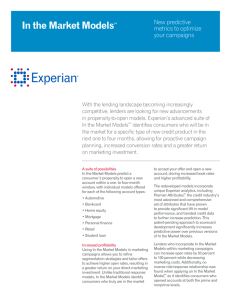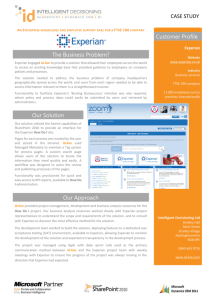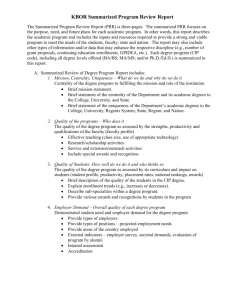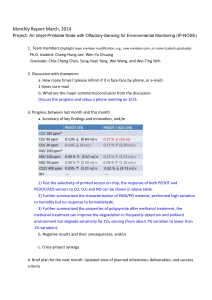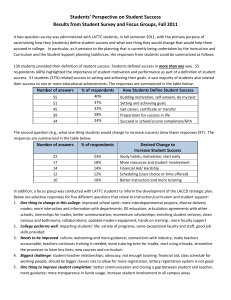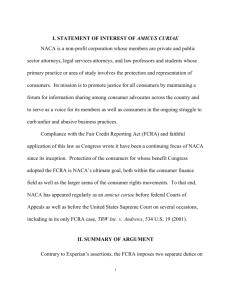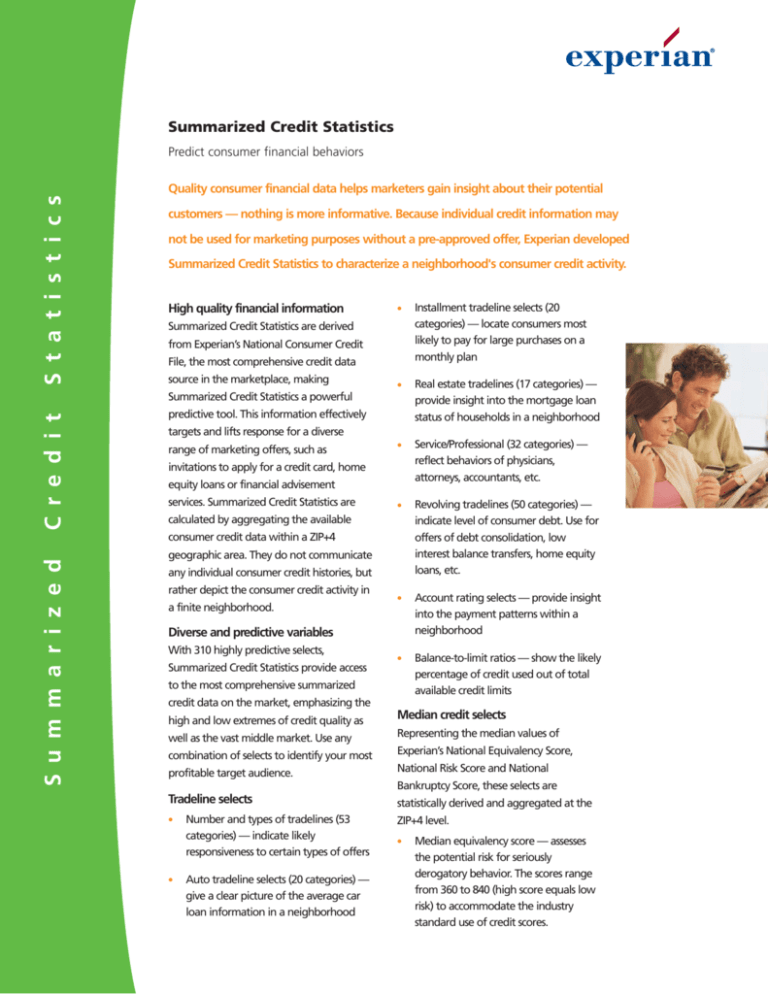
Summarized Credit Statistics
S t a t i s t i c s
Predict consumer financial behaviors
Quality consumer financial data helps marketers gain insight about their potential
customers — nothing is more informative. Because individual credit information may
not be used for marketing purposes without a pre-approved offer, Experian developed
Summarized Credit Statistics to characterize a neighborhood's consumer credit activity.
High quality financial information
z
Summarized Credit Statistics are derived
from Experian’s National Consumer Credit
File, the most comprehensive credit data
source in the marketplace, making
z
S u m m a r i z e d
C r e d i t
Summarized Credit Statistics a powerful
predictive tool. This information effectively
targets and lifts response for a diverse
range of marketing offers, such as
z
invitations to apply for a credit card, home
equity loans or financial advisement
services. Summarized Credit Statistics are
z
calculated by aggregating the available
consumer credit data within a ZIP+4
geographic area. They do not communicate
any individual consumer credit histories, but
rather depict the consumer credit activity in
a finite neighborhood.
z
Diverse and predictive variables
With 310 highly predictive selects,
Summarized Credit Statistics provide access
z
to the most comprehensive summarized
credit data on the market, emphasizing the
high and low extremes of credit quality as
well as the vast middle market. Use any
combination of selects to identify your most
Installment tradeline selects (20
categories) — locate consumers most
likely to pay for large purchases on a
monthly plan
Real estate tradelines (17 categories) —
provide insight into the mortgage loan
status of households in a neighborhood
Service/Professional (32 categories) —
reflect behaviors of physicians,
attorneys, accountants, etc.
Revolving tradelines (50 categories) —
indicate level of consumer debt. Use for
offers of debt consolidation, low
interest balance transfers, home equity
loans, etc.
Account rating selects — provide insight
into the payment patterns within a
neighborhood
Balance-to-limit ratios — show the likely
percentage of credit used out of total
available credit limits
Median credit selects
Representing the median values of
Experian’s National Equivalency Score,
profitable target audience.
National Risk Score and National
Tradeline selects
statistically derived and aggregated at the
z
z
Number and types of tradelines (53
categories) — indicate likely
responsiveness to certain types of offers
Auto tradeline selects (20 categories) —
give a clear picture of the average car
loan information in a neighborhood
Bankruptcy Score, these selects are
ZIP+4 level.
z
Median equivalency score — assesses
the potential risk for seriously
derogatory behavior. The scores range
from 360 to 840 (high score equals low
risk) to accommodate the industry
standard use of credit scores.
z
z
Median risk score — similar to median
equivalency score, this option also
characterizes neighborhoods or market
segments based on their likelihood of
having future derogatory credit activity.
This score range (0-1000) has a direct
correlation, where a low score equals low
risk.
INSOURCESM data adds insight
Median bankruptcy score — pinpoints
neighborhoods or market segments that
may be more likely to file for bankruptcy
or become seriously delinquent over the
next 12 months. This score is a leading
indicator of potential derogatory
impacts. Scores range from 108 to 1257,
with a high score indicating greater
likelihood.
million living units. Select from variables such
Streamline and simplify with factor
variables
For some prospecting, activation and/or
usage scoring model applications, it may not
be practical to select from the multitude of
granular level detail available in the
independent Summarized Credit Statistics
variables. As an alternative, Experian® has
developed Summarized Credit Statistics
factor variables — weighted roll-ups of the
310 available selects into six broader, more
manageable categories. Designed to alleviate
time and other constraints, Factor variables
have been validated for accuracy and
predictability. Choose from these six factor
Target more precisely by combining the
predictive power of Summarized Credit
Statistics with a comprehensive array of
demographic and realty data and other life
event triggers from INSOURCE. Experian’s
consumer database contains marketing
information on 215 million individuals in 110
as age, estimated household income,
presence of children, automotive preference,
estimated current home value and mortgage
information.
Additional applications
Marketers can incorporate Summarized
Credit Statistics into a wide variety of
Experian applications, including data
enhancement and custom modeling. Choose
any combination of 310 data variables in the
file to enhance your own consumer file. Use
this data to build your own models — or
utilize Experian’s industry-leading analytic
expertise to create custom models — to
predict response, activation, multi-buyers and
retention rates. In addition, Experian offers
several Summarized Credit Statistics licensing
packages.
Respect for consumer privacy
You can be confident that our data solutions
comply with state and federal regulations
and consumers' privacy expectations. We
variables:
review all the marketing products and
Factor 1 - good vs. bad credit
Factor 2 - installment trades
opportunities we undertake for privacy
Factor 3 - active users
information values. The process produces
services we develop and the business
Factor 4 - delinquent service/professional
trades
Factor 5 - seeking credit
Factor 6 - extended revolving trades
compliance and integrity with our
direct marketing solutions that you and
consumers can trust.
To find out more about Summarized Credit
Statistics, contact your Experian sales
955 American Lane
Schaumburg, IL 60173-4998
representative or call
800 850 4389
800 850 4389.
©Experian 2004
All rights reserved
Experian and the marks used herein are service marks or
registered trademarks of Experian.
5842/3091 10/04
www.experian.com



